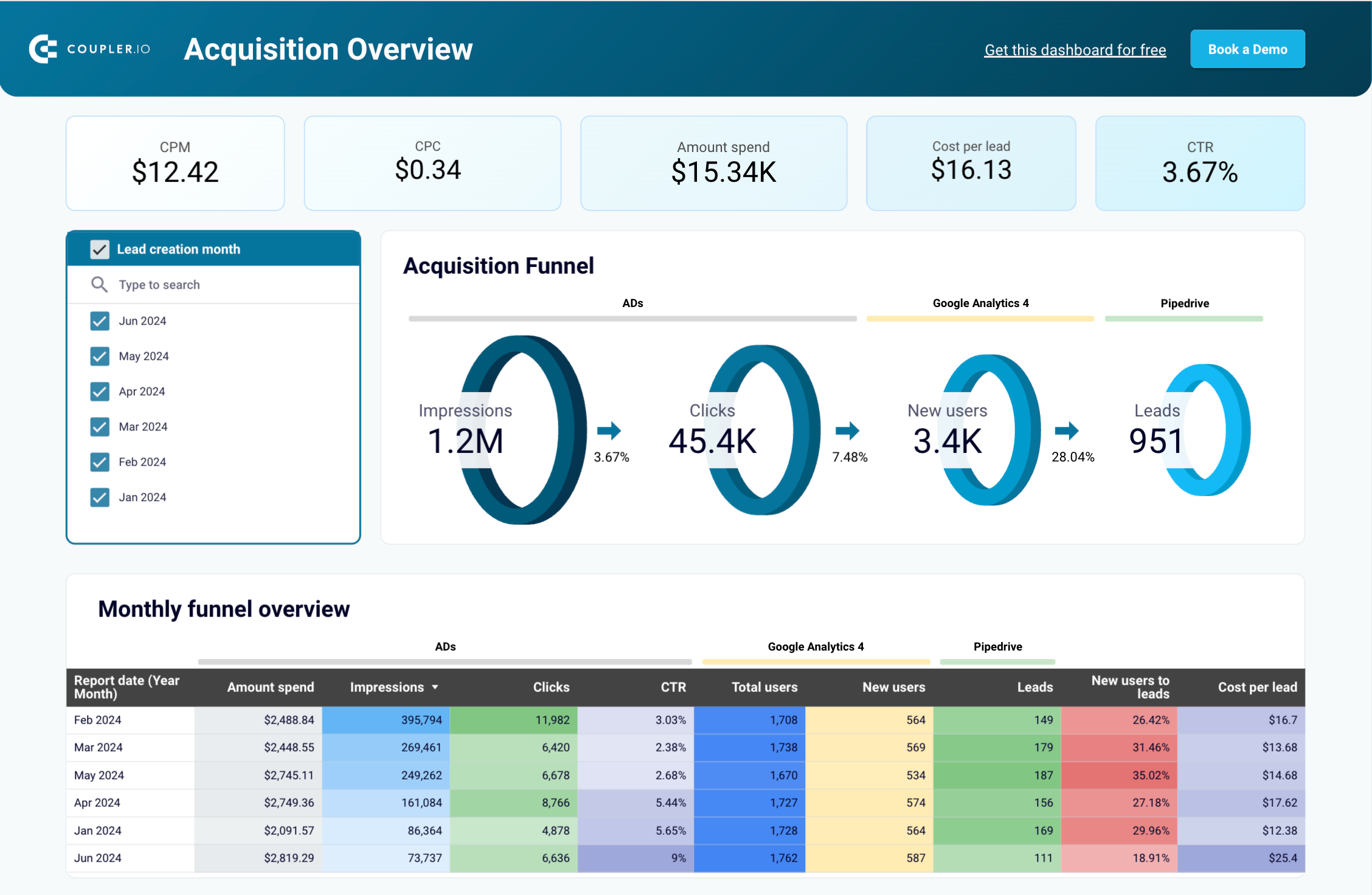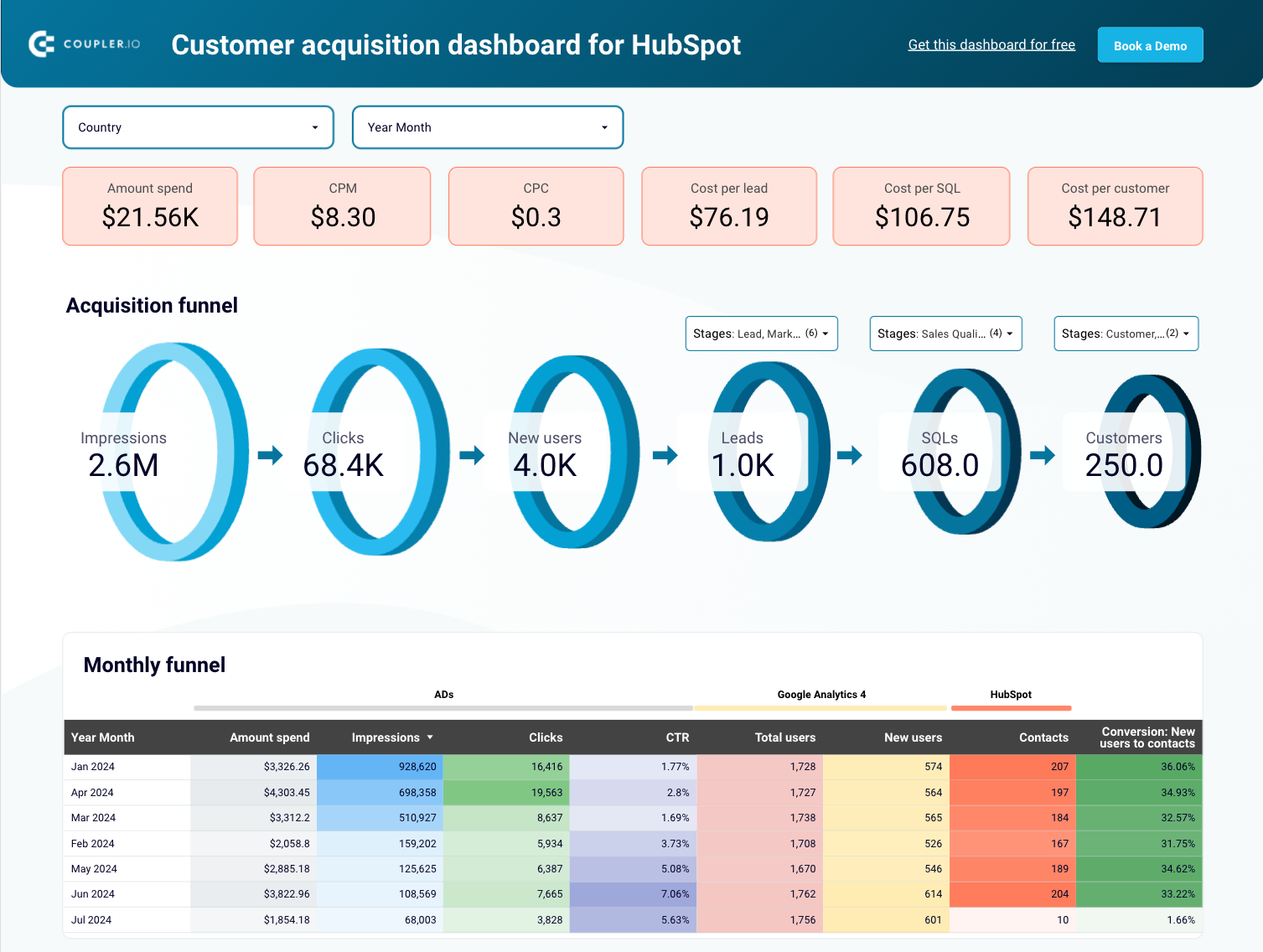Funnels are valuable tools for sales and marketing teams. They help measure the effectiveness of your marketing campaigns and optimize content for conversion. But what exactly is the difference between a marketing funnel and a sales funnel? If they both represent the buyer journey, can’t you use them interchangeably?
The short answer is no, but there are situations where funnels can be combined or managed concurrently. But before we get into the specifics, let’s start by exploring the key differences between these two funnels.
Marketing funnel vs sales funnel: Main differences
| Aspect | Marketing Funnel | Sales Funnel |
|---|---|---|
| Strategy | Create product awareness among the target audience, generate leads, and convert interested prospects into paying customers. | Identify business prospects, establish communication, negotiate and close the deal, and manage the business relationship. |
| Stages | 1. Awareness 2. Interest 3. Consideration 4. Intent 5. Evaluation 6. Buy | 1. Prospecting 2. Lead qualification 3. Negotiation 4. Demo 5. Close (deal lost or won) |
| Customer interaction | Minimal/non-existent until the last stages, especially if you have a self-service purchasing model | High-level at the ToFu, becoming more frequent and personalized towards the later stages |
| Key metrics | – Impressions – Reach – Leads generated – Click-through rate (CTR) – Conversion rate – Cost per acquisition (CPA) – Revenue | – Qualified leads – Conversion rate (lead to sale) – Closed deals – Deal amount – Lost deals – Revenue |
| Who uses it | Various members of the marketing team, including SEOs, PPC experts, content creators, etc. | The sales team, such as sales development reps and account managers. |
| Key activities | – Content marketing (e.g. articles, webinars, social media) – Ad and outreach campaigns – Nurturing campaigns – Free trial promotion | – Networking and prospecting – Lead segmentation – Email campaigns – Product demos – Deal negotiations – Follow-up and deal-closing |
Other important aspects to know about marketing vs sales funnels:
- A marketing funnel starts with an audience, while a sales funnel starts with a batch of prospects. In marketing, target customers are people with similar characteristics (job titles, demographics, locations, etc.). In sales, prospects are specific companies and decision-makers who match the customer profile – not nameless groups.
- Marketing and sales teams aren’t the only users. It almost goes without saying, but funnels are important assets for other internal stakeholders like designers, product managers, and C-levels. Funnel data often has a direct impact on business decision-making.
- The marketing funnel is content-heavy, while the sales funnel is more person-oriented. For example, communication throughout the sales funnel is more direct and hands-on. Think LinkedIn DMs, email threads, and demo calls vs. blog posts, YouTube ads, and no-reply re-engagement emails.
How are the funnels similar?
Now that we’ve established the key differences between sales and marketing funnels, let’s explore the crossover.
Combined marketing and sales funnel
Many businesses rely on a combined funnel to measure the impact of their marketing campaigns. This type of funnel is common among B2C or companies with small sales and marketing departments. Teams work closely to ensure all aspects of the customer journey are covered. They also share a common strategy and collaborate on the same campaigns.
In an integrated funnel, the top and middle levels are marketing-focused, while the bottom represents the sales aspect of the journey. It will have more or less the following structure, depending on the framework you use:
- Awareness
- Interest
- Consideration
- Evaluation
- Demo (optional)
- Purchase
- Retention/Upselling (optional)
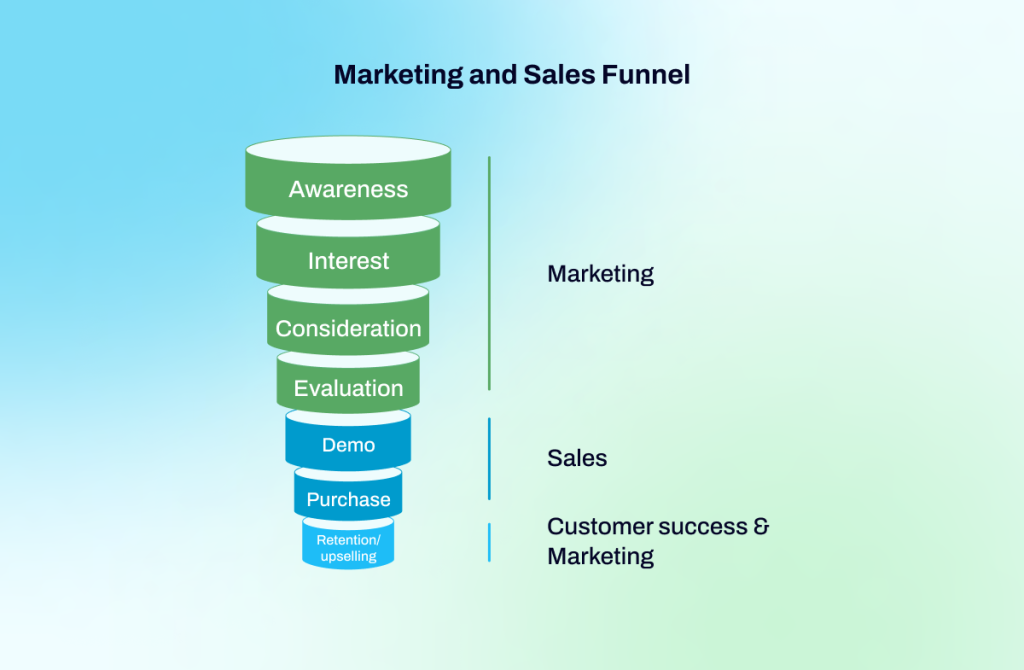
At the top of the funnel (ToFu), the goal is to generate brand awareness and engage the target audience. This may involve running paid ads, creating SEO-optimized content, launching outreach campaigns (email sequences, content collaborations), and PR activity (e.g. conference appearances).
At the middle of the funnel (MoFu), the aim is to position your product or service as the best option on the market. Social proof is critical at this stage. You should provide content like case studies, client testimonials, whitepapers, and webinars to help your leads make a decision.
The bottom of the funnel (BoFu) – stages ‘demo’ and ‘purchase’ – is where the transition from marketing to sales happens. If a product demo or assessment call is needed, then the sales team takes over from here. Otherwise, the prospect reaches out for a custom quote or makes the purchase themselves.
Lastly, the funnel also includes an upselling or retention component. This occurs after the customer makes a purchase. Here, marketing collaborates with sales and customer success to create added value and drive repeat purchases. For example, they deliver assets like a knowledge hub and video tutorials to aid onboarding. Other activities may include warm email campaigns, seasonal promotions, or referral programs.
Alternatives to integrated funnels
Funnels exist in parallel
Marketing and sales teams don’t always work in tandem. For instance, if your business has more than one type of sales model, it’s typical to maintain separate funnels for each process. This allows you to cover all segments of your target market.
There are two main types of purchasing models: self-service and white glove. In general, marketing is responsible for promoting the former, while the sales team manages the latter. They will use either a marketing funnel or a sales funnel to structure each process, as demonstrated below:
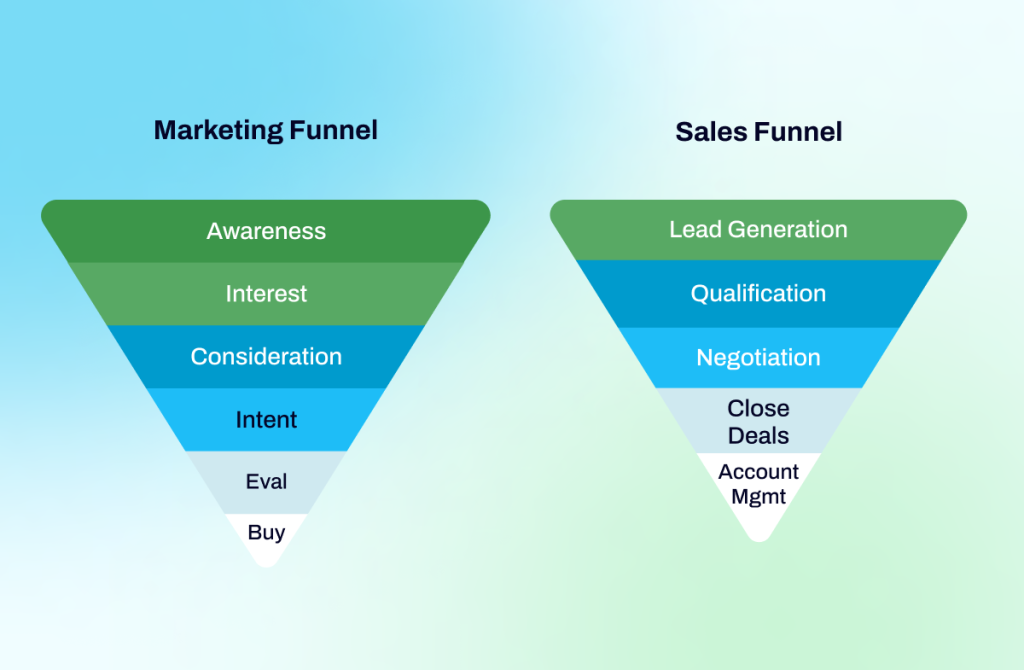
To put this parallel approach into context, let’s take a B2B SaaS example like Coupler.io. We have a self-service purchasing model, custom solutions for enterprises, and a white-glove data analytics service.
We rely on a marketing funnel to attract and nurture segments with basic needs – for example, small teams or professionals who would benefit from our standard plans. On the other hand, our sales funnel caters to prospects with enterprise-level needs, such as clients with large, distributed teams.
As always, the marketing funnel ends in a purchase. But in this case, the customer does not interact with the sales team – they simply enter their credit card details. Meanwhile, the sales team is busy ushering a separate batch of qualified prospects through the sales funnel. The final stages are usually more intense, marked by follow-up emails, calls, demos, and back-and-forth deal negotiations.
Even though the funnels are entirely separate, their end goal is the same – customer acquisition. That’s why sales and marketing teams must keep each other informed about strategies, customer feedback, industry trends, and wins or losses.
Single funnel for a prioritized activity
Some businesses prefer to work with a single funnel (as an alternative to an integrated or parallel sales and marketing process). Typically, they will choose a traditional sales funnel – much like the one we discussed above – over a marketing one. There are several reasons why this happens:
- Business model and industry. For many B2Bs – especially those who compete for large contracts – marketing isn’t needed. Relationship building is much more important. Proper lead qualification often provides a better ROI than blog posts and social media ads.
- Limited resources. Not every business can afford a dedicated marketing or sales team. It’s more efficient to scale a single activity (sales or marketing), at least in the early stages of your life cycle.
- Revenue and growth goals. As we mentioned earlier, sales efforts are more targeted and person-oriented. This approach can be helpful if you want to increase the chances of reaching the right people – and landing more lucrative deals.
Let’s take a B2B software consultancy as an example. The company relies on a sales team to source and vet prospects – for example, product startups who may need help building or scaling their engineering efforts. It further qualifies those leads using data markers like professional titles, geo-location, company size, etc. This generates a list of businesses and decision-makers to contact.
The team conducts email outreach campaigns, sets up calls with interested prospects, and negotiates deals (with stakeholder support). As a result, the business’s five-stage sales funnel looks something like this:
- Lead generation
- Qualification
- Client call
- Proposal
- Close deal.
This is a clear case of sales funnel vs marketing funnel. If the company used a marketing funnel instead of a sales one, it would not achieve the same results. The audience would be too broad and the messaging too impersonal.
Of course, it could still run a parallel marketing process, as we described in the previous section. But since it doesn’t have conflicting purchasing models, it’s not essential.
Flywheel vs marketing funnel
The marketing ‘flywheel’ is the best-known funnel alternative. It was developed by HubSpot to demonstrate the value of inbound marketing and align teams around the methodology.
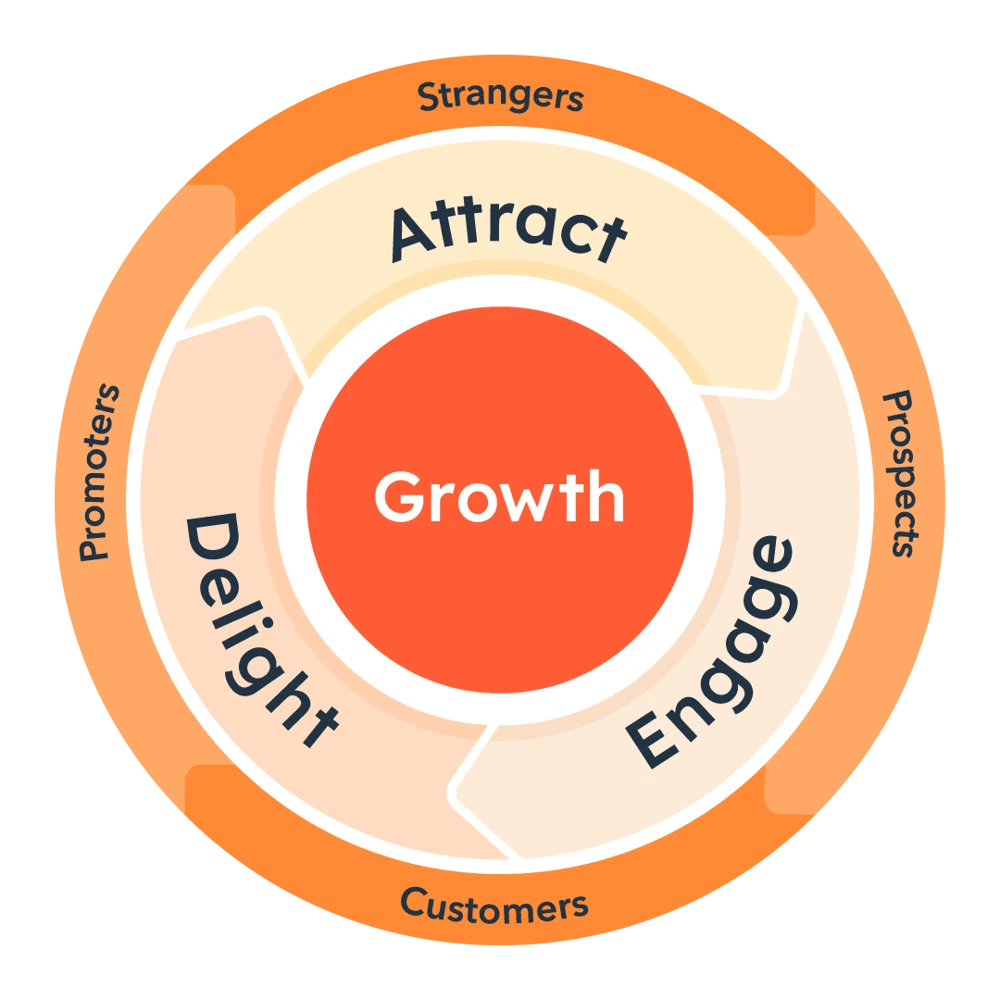
The flywheel has three interconnected phases: Attract, Engage, and Delight. In the Attract phase, you create helpful content to draw in potential customers. In the Engage phase, you nurture leads with personalized emails, ads, or landing pages and interact with them on relevant platforms. In the Delight phase, you empower customers with proactive service, tailored content, a knowledge base, etc.
Crucially, a flywheel has no ‘final’ stage. Unlike the funnel, it accounts for the momentum generated by previous sales. It also puts a greater emphasis on customer retention and advocacy. For those reasons, businesses with cyclical or non-linear sales processes may find the flywheel more effective than a funnel.
Visualize your funnels with Coupler.io
It’s easier to make funnel improvements when you can track metrics in near real-time. Auto-updating dashboards from Coupler.io, a reporting automation tool, offer such tracking and much more. Here are a couple of free marketing and sales funnel templates to get you started.
Customer acquisition dashboard for Pipedrive
A customer acquisition dashboard can help you understand how ad impressions translate into leads and customers. This template for Pipedrive features a funnel visualization with four stages: impressions, clicks, new users, and leads. The dashboard pulls data from multiple sources, including ad platforms and your GA4 and Pipedrive accounts. It lets you analyze each stage of the funnel, identify potential bottlenecks, and get clues on how to optimize the flow.
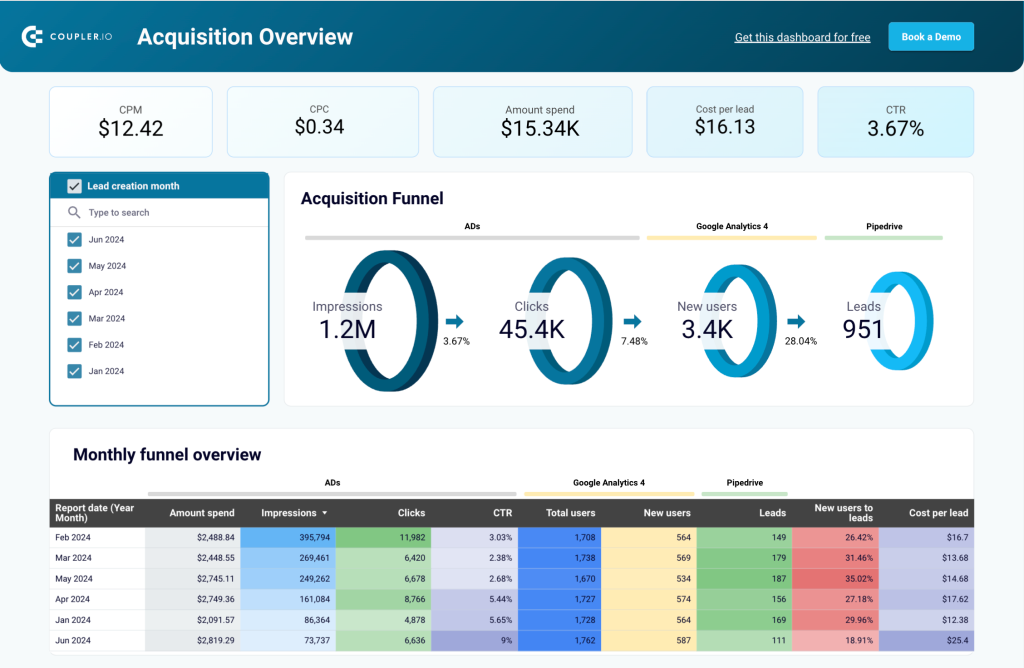
Learn more about marketing funnel reporting.
Detailed graphs also allow you to measure important metrics like total amount spend, cost per lead, conversion rates, and more. Use those insights to monitor trends, improve funnel efficiency, and enhance your sales analytics process.
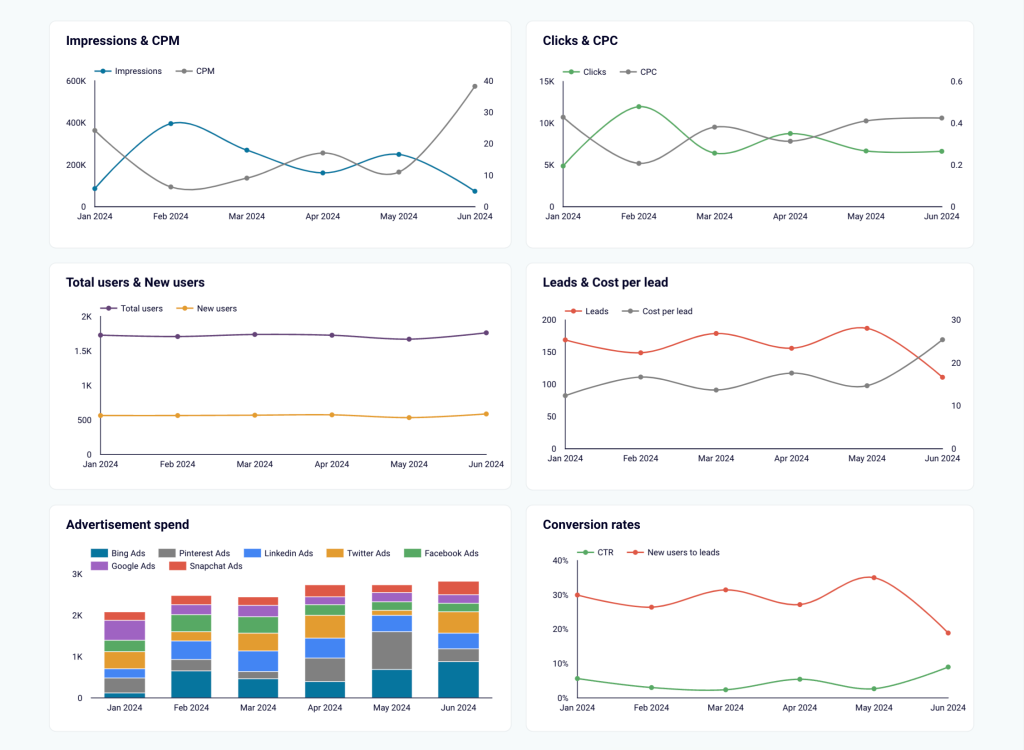
This dashboard is available as a free template in Looker Studio. To use it, simply set up a Coupler.io account, create an importer, and connect your ads, GA4, and Pipedrive data. The dashboard’s Readme tab provides full set-up instructions.
Sales funnel dashboard for Shopify
This dashboard helps e-commerce businesses understand how website visits convert into purchases. It provides a sales funnel overview and a detailed breakdown of funnel metrics, including total users, page views, checkouts, purchases, and more. You can filter purchases by source (e.g. Google, blog, YouTube) to identify which promotional channels generate the most revenue for your business.
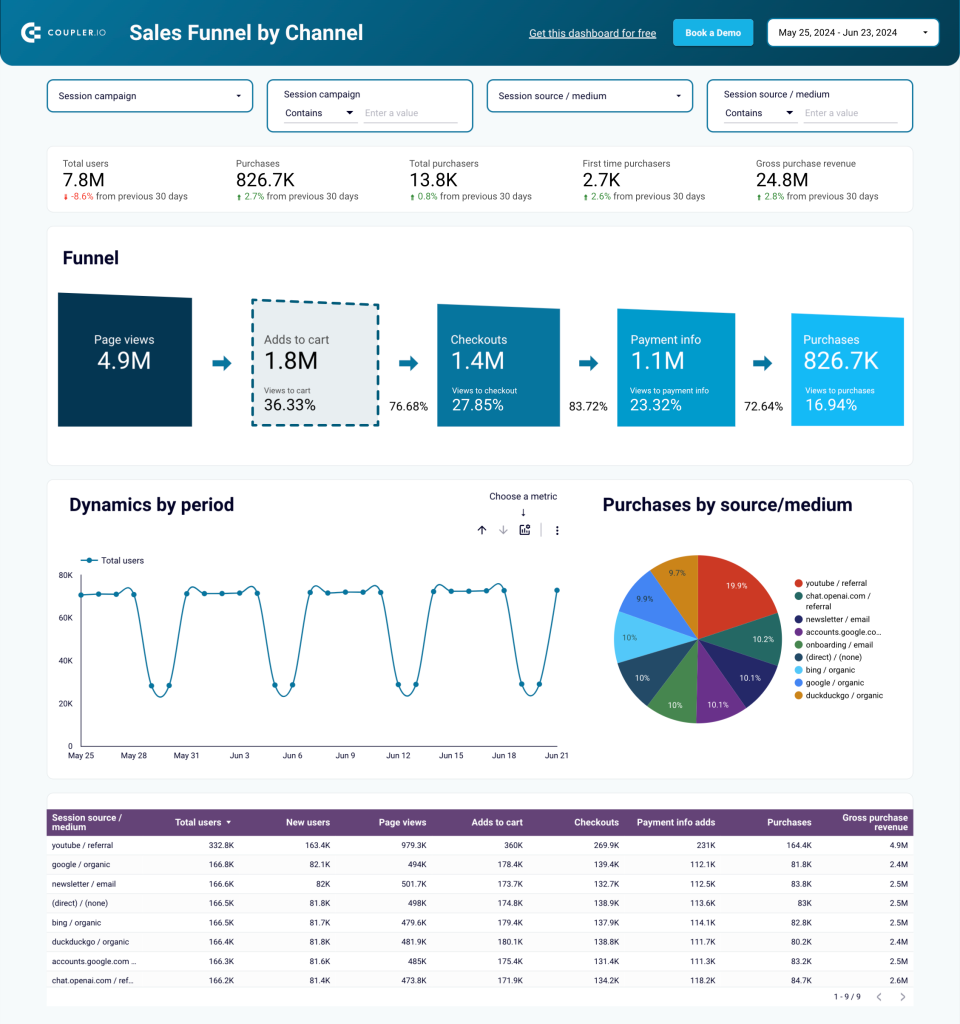
If you navigate the dashboard menu, you will see two other options for visualizing the sales funnel – by country and by item. You can use location data to improve ad targeting, and item data to create stronger campaigns around your most popular products.
Like the previous dashboard example, this template is built in Looker Studio. This time, you only need to connect your GA4 and Shopify accounts to start using it. Again, it only takes a few minutes to set up and you can use the dashboard forever with a Coupler.io free plan.
How to build a funnel without data
What if you don’t have organic data to build a funnel with? In that case, you can create a funnel outline based on customer research. Find out as much about your potential audience or prospects as possible. What are their pains, motivations, and goals? What channels might they use to discover your product? And what steps must they take to purchase your product? This information will help shape your initial strategy. It will also enrich your marketing analytics process in general.
Here are a few ways to gather the needed data:
- Do market and competitor research to create Ideal Customer Profiles (ICPs). When you finally get data from real customers, refine and expand those profiles with behavioral insights.
- Run a discovery session using a framework like BRIDGeS. List your target customers as subjects, then dig into their problems, goals, and shared contexts. Use this knowledge to define funnel activities.
- Interview potential customers. Reach out to people who match your ICP (e.g. LinkedIn connections, former colleagues) and invite them to a video call. You can use an incentive, like a gift card, to increase the chances of engagement. Find out which alternatives they use, how they usually shop, which marketing channels they prefer, pricing expectations, etc.
The first version of your funnel will not be 100% reliable. But as you iterate with fresh data, the value of your funnel will increase.
Explore more about Marketing Mix Model.
How to optimize your funnels
Despite their differences, sales and marketing funnels have the same goal: to to convert visitors/prospects into customers. Here are a few ways to improve the chances of conversion with either funnel.
Create high-quality content
The more useful your content is, the more effective your funnel will be. Aim to pack as much value as possible into your funnel activities by:
- Prioritizing clarity and conciseness in your blog content
- Ensuring ads have clear CTAs and address real pain points
- Experimenting with landing page copy to see which messages resonate the most
- Including social proof in your cold email outreach
Personalize messaging and communication
Research by McKinsey shows that consumers are 76% more likely to purchase from companies that personalize the customer experience. So, aim to make your messaging as targeted as possible, especially in the middle of the funnel.
From the marketing side, this might look like a tailored set of ads or an email sequence triggered by a visit to the pricing page. From a sales funnel perspective, it might involve sharing industry-specific use cases during the demo call.
Use customer feedback
Use customer feedback to improve the overall experience and boost conversions. For instance, you could survey new customers to understand how they learned about your product, what type of resources they found helpful, and their decision-making factors. The sales team could also survey prospects who left the funnel at the negotiation stage. By finding out why a deal failed, you can prevent similar drop-offs in the future.
Automate when it makes sense
Don’t be afraid to automate some funnel activities, especially if it will save everyone time. For example, you might use a scheduling tool like Calendly to speed up the demo call booking process. It’s also a good idea to automate content recommendations based on the funnel stage or create email sequences to reduce manual follow-up.
Sales funnel vs marketing funnel: Which is the better option?
There is no one-size-fits-all funnel model. Each has its merits and specific use cases. Moreover, functional conversion funnels are one of the top marketing trends this year. You can have a marketing funnel based on the AARRR framework or a custom sales funnel tailored to your niche. The precise structure doesn’t matter, as long as it reflects your marketing/sales process and customer decision journey stages.
To sum up, there is no clear winner in the sales vs marketing funnel debate. But when you build your marketing or sales process around the right one, you will see better results and higher conversions for your business.
If you liked these funnel visualizations, why not try some of our other dashboard templates for marketing and sales? Examples include a Sales KPI dashboard, PPC multi-channel dashboard, and other great reports for social media, paid ads, and CRM analysis. Check them out!

